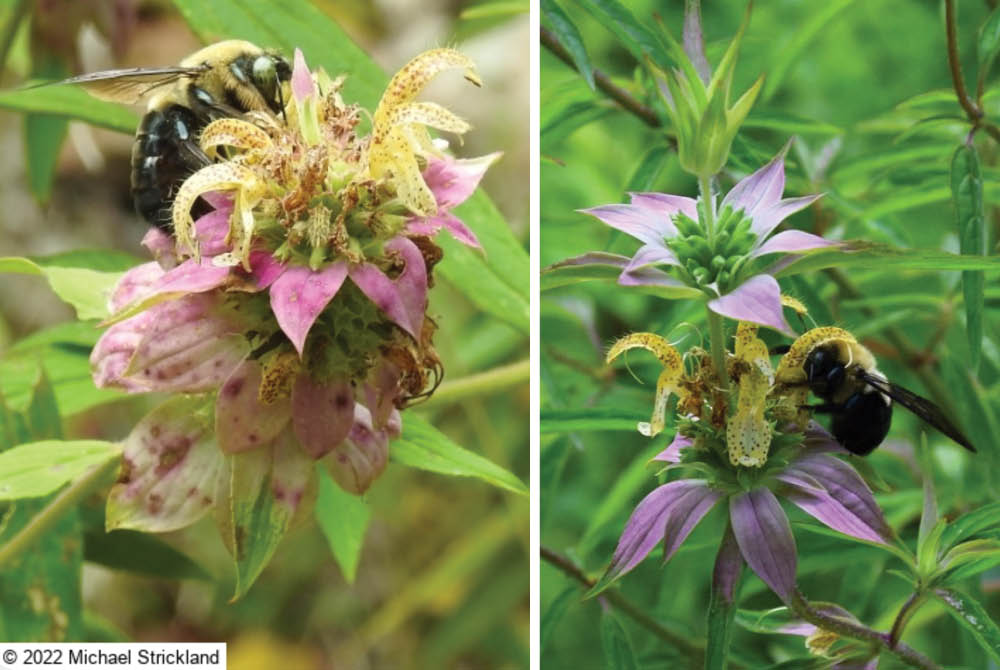2023 Plant of the Year: Spotted Beebalm

2023 Plant of the Year: Spotted beebalm
Spotted beebalm (Monarda punctata) is a beautiful and hardy herb, and the GNPS welcomes it as our newest Plant of the Year. A member of the mint (Lamiaceae) family, its natural habitats are woodland margins, sand hills, and coastal plains east of the Rocky Mountains. The genus was named after Nicolas Monardes, a Spanish botanist, whose 3-part book “Historia medicinal de las cosas que se traen de nuestras Indias Occidentales”, written between 1565 and 1574, describes the flora of the Americas. The species name “punctata” means “spotted”, referring to markings on the flower petals.
Spotted beebalm’s most distinguishing feature is its exquisite inflorescence. Flower heads stack atop one another, pierced by the stem, forming a dense spike (cyme) 3-6” long. Each flower head is about an inch around, and consists of a rosette of pink-violet bracts (these can be almost white to vivid violet) capped by a fountain of individual small flowers. Their corollas are double-lipped, with downward arching petals that are creamy yellow and sprinkled with dark purple dots. These dots serve as “nectar guides” to direct insects, particularly bees [1,2]. A whorl of erect, pale green bracts crowns the terminal flower head. Multiple ecotypes of the species exist, so depending on the origin of the seed, flowers may vary slightly in appearance. The flowering season for spotted beebalm is July-September. In autumn, its showy flowerheads morph into dark brown seedheads, filled with tiny seeds.
Flowers may vary in appearance. Note the differences in color and shape of the bracts. (Left and middle photos by V. Boss; right photo by Mike Strickland).
Insects adore spotted beebalm. Its blossoms are a source of pollen and nectar for numerous wasps, including Sphex pensylvanicus, Monobia quadridens, and Ammophila procera; honey bees; specialized native bees, such as Dufourea monardae, Perdita gerhardi, and Protandrena abdominalis; and at least 7 species of butterfly and moth. In addition, native Monardas in general are larval hosts for many moths, including Anterastria teratophora, Lintneria eremitus, and at least 3 species of genus Pyrausta.
Whether hummingbirds feed on spotted beebalm is debatable. Many sources state that members of the genus Monarda attract hummingbirds, but some may not. Monarda is segregated into two subgenera: Monarda and Cheilyctis, distinguished by morphology. Species in the subgenus Monarda (for example, M. didyma and M. fistulosa) are visited by hummingbirds that feed on their copious and accessible nectar. However, the 16 plants in the subgenus Cheilyctis, which includes M. punctata, are less likely to attract hummingbirds because access to the relatively small nectaries at the bases of their corollas is restricted [1].

Left: Fall seedheads are dark brown and button-shaped (photo by Valerie Boss). Right: Flowers in various stages along stem (photo by Ellen Honeycutt).
Spotted beebalm grows to 2-3’ in height. Its stems are erect, 4-sided, simple or sometimes branched, and have soft hairs. Leaves are opposite, hairy, lanceolate, and toothed, growing to about 3” long. Like other members of the mint family, the leaves are pungent and rich in aromatic essential oil, which is medicinal if used with caution. The most abundant compound in spotted beebalm’s essential oil is thymol (50-75%), with lesser contributions from p-cymene, limonene, and carvacrol [3,4]. The concentration of thymol is much greater than that found in other mints, or in aromatic culinary herbs, like oregano. Thymol is antibacterial, and spotted beebalm’s complete essential oil is even better than thymol alone at fighting microbes [3]. Thymol is also toxic, except in very low concentrations. Native Americans historically employed spotted beebalm as a remedy for a variety of ills (detailed information can be found by searching the American Native Ethnobotany Database). Most modern users take it as a very weak tea for respiratory or digestive ailments. The leaves can also be sprinkled on food as a flavoring, but sparingly, owing to their potential toxicity.
Spotted beebalm is an excellent choice for a rock or herb garden. Drought tolerant, it likes plenty of light and well-drained soil, and can handle stony or sandy conditions. Individual plants survive only a few seasons, but they re-seed easily. Grouped in clusters, spotted beebalm catches the eye, as do the myriad insects that thrive on its flowers.
[1] Scora, R. W. (1964) “Dependency of pollination on patterns in Monarda (Labiatae).” Nature 204: 1011-12.
[2] Meeuse, J.D. (1963) The story of pollination, p36-46.
[3] Li, H., Yang, T., Li, F-Y., Yao, Y., Sun, Z.M. (2014) “Antibacterial activity and mechanism of action of Monarda punctata essential oil and its main components against common bacterial pathogens in respiratory tract.” Int J Clin Exp Pathol. 7(11): 7389–7398.
[4] Lawson, S.K., Satyal, P., Setzer, W.N. (2021) “The volatile phytochemistry of Monarda species growing in South Alabama.” Plants (Basel)10(3): 482
Credits: Text by Valerie Boss. Photos by Valerie Boss, Ellen Honeycutt, and Mike Strickland.

